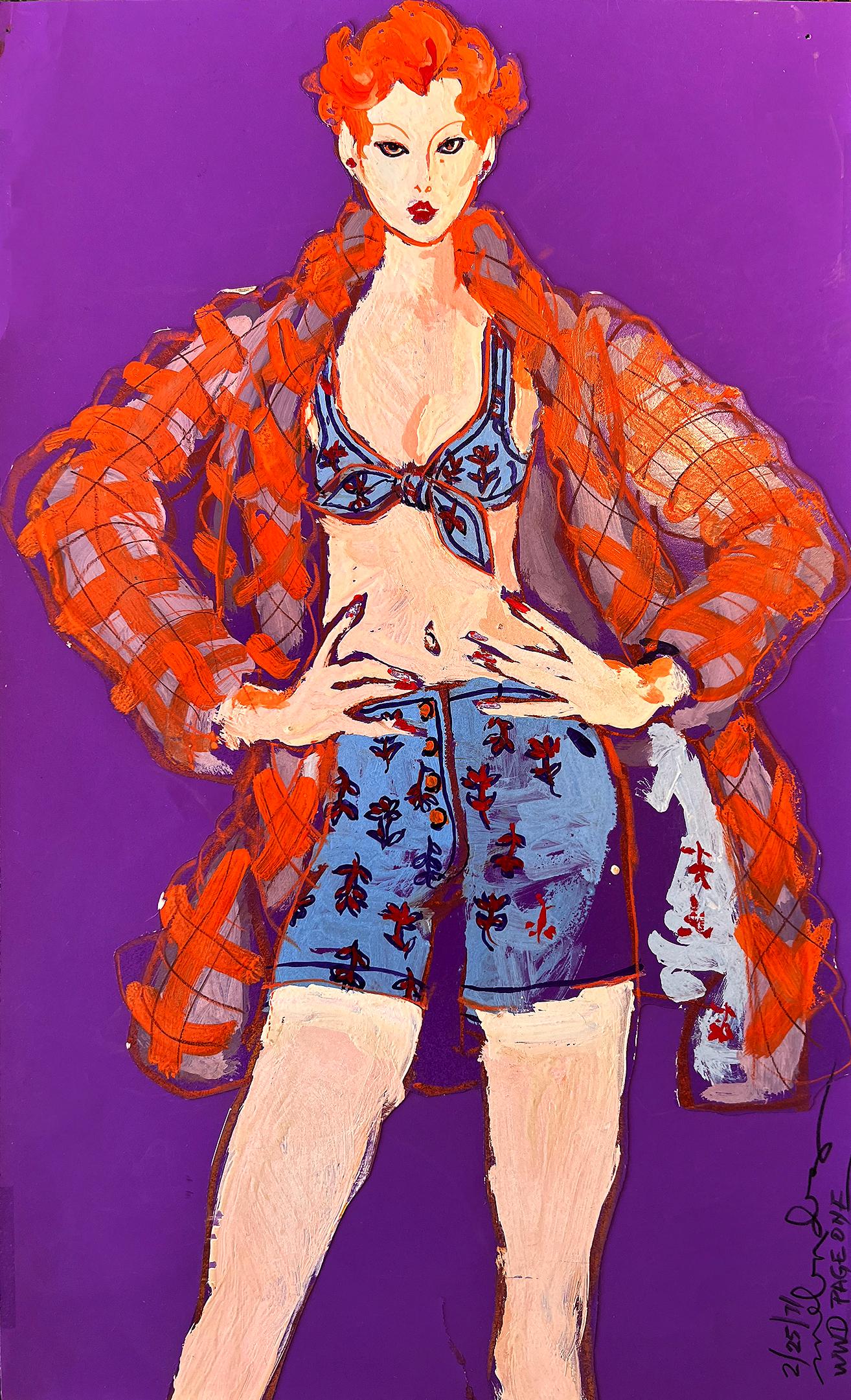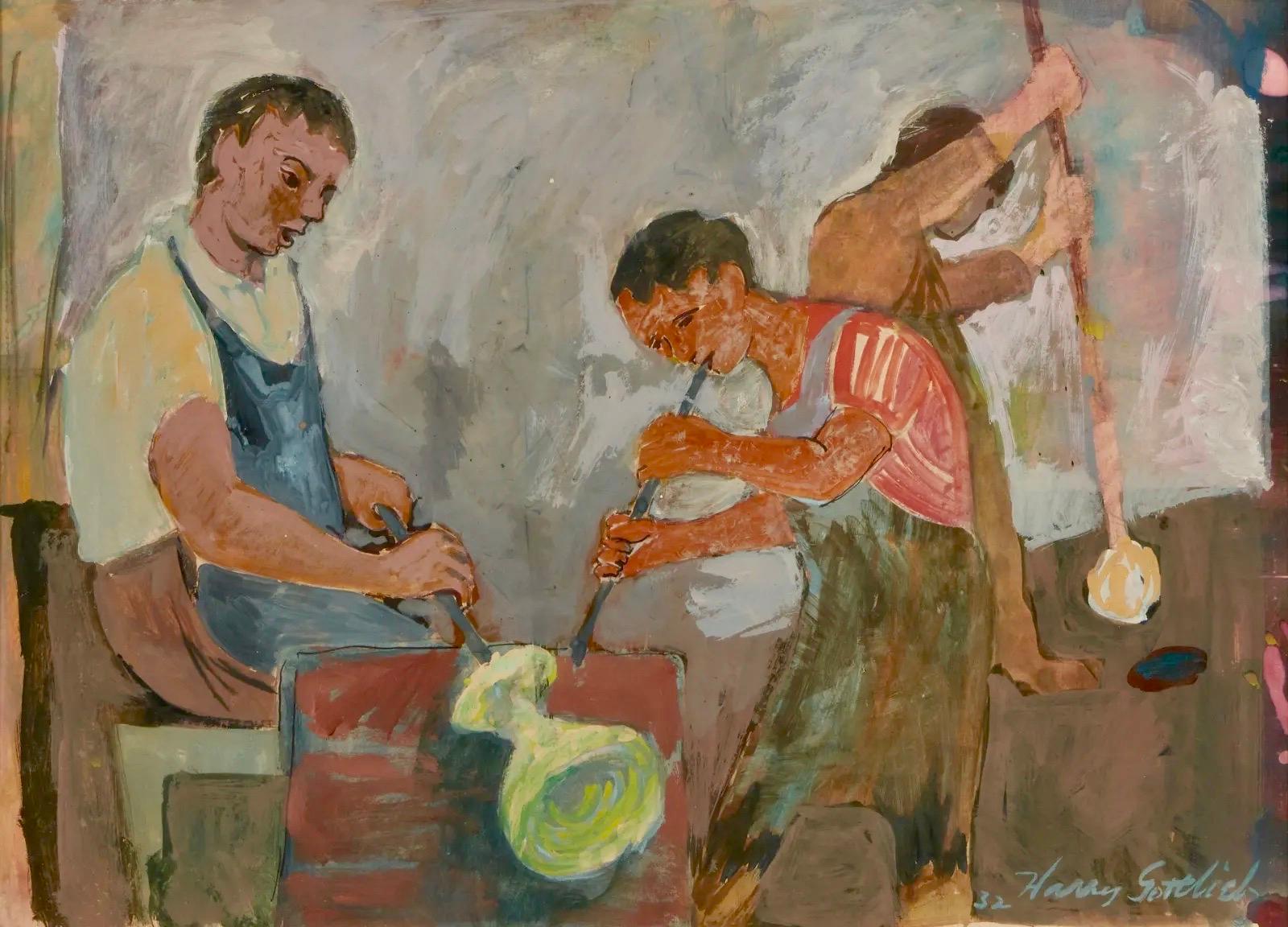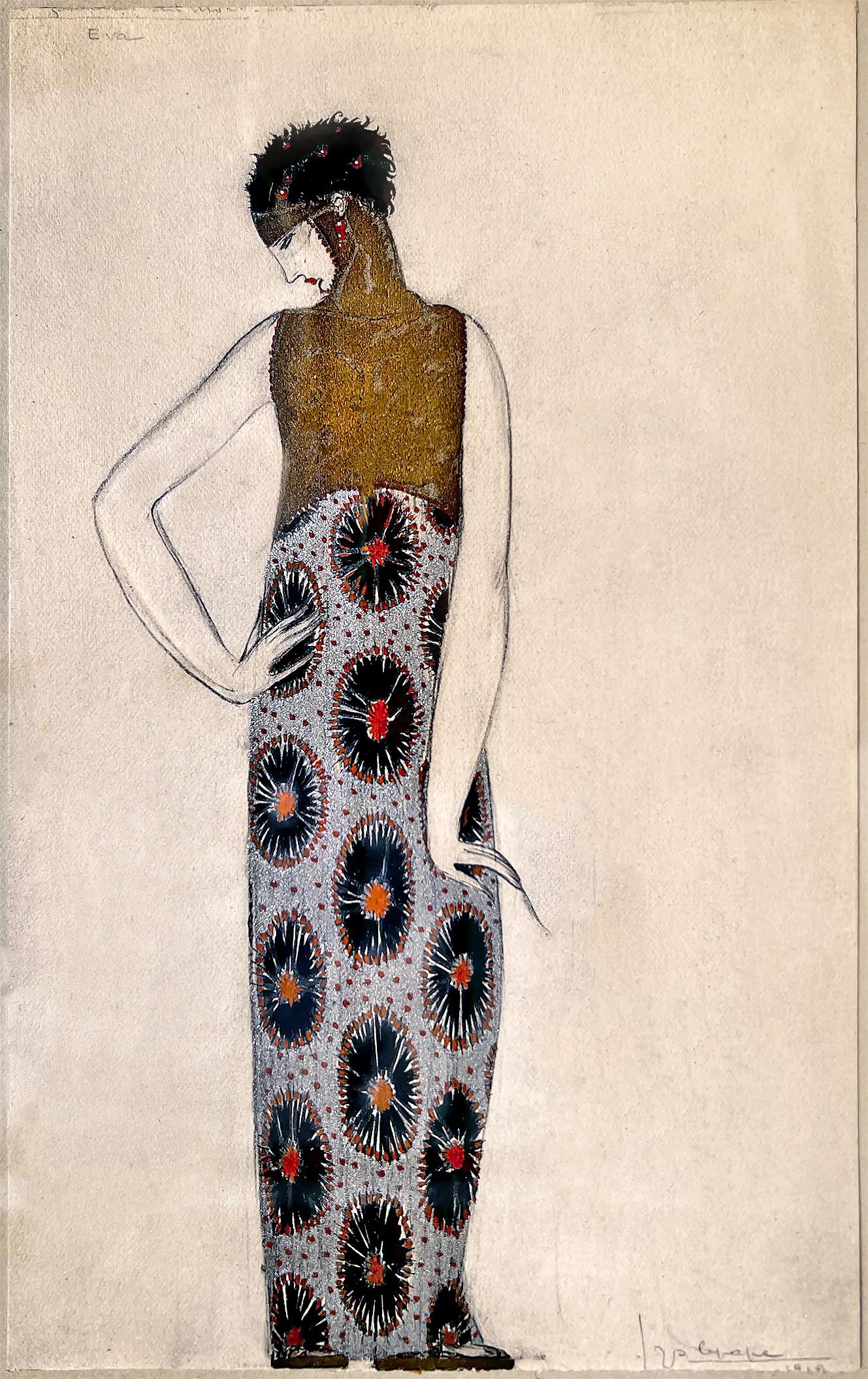Items Similar to French School (18th Century) Dancing Putti.
Want more images or videos?
Request additional images or videos from the seller
1 of 4
UnknownFrench School (18th Century) Dancing Putti. Circa 1790
Circa 1790
About the Item
French School (18th Century), Dancing Putti.
This gouache on vellum scene of the dancing putti is derived from a drawing by Giovanni Antonio de' Sacchis (Italian 1484 -1539) known as Pordenone II.
The rococo movement began after 1715 when France welcomed a new king for the first time in seventy-two years, Louis XV succeeded his great-grandfather Louis XIV, the Sun King, who had made France the preeminent power in Europe. The late king's nephew, the duc d'Orléans, governed the next eight years as regent. France turned away from imperial aspirations to focus on more personal and pleasurable pursuits. Artists shifted from grandiloquence to the sensual surface delights of colour and light, and more intimate mythological scenes, views of daily life, and portraiture. Leaving behind to a degree religious and historical subjects. This work and its frame personify the rococo period, the putti are rendered by a skilled hand and delicately painted this is a truly unique work.
Provenance: Rupert and Robin Hambro, London. From the collection of late banking heir and philanthropist Rupert Hambro (Hambros Bank) and his wife Robin, a former model and editor of Vogue. Rupert Hambro was Treasurer of the National Art Collections Fund, Chairman of The Museum of London, The Silver Trust and The Royal College of Art London.
- Creation Year:Circa 1790
- Dimensions:Height: 6.42 in (16.3 cm)Width: 11.03 in (28 cm)
- Medium:
- Movement & Style:
- Period:
- Condition:The work and the original period French Rococo frame are in excellent condition. The frame is glazed with anti-reflective UV-resistant Museum Glass.
- Gallery Location:Sydney, AU
- Reference Number:1stDibs: LU1971214121332
About the Seller
No Reviews Yet
Vetted Seller
These experienced sellers undergo a comprehensive evaluation by our team of in-house experts.
Established in 2011
1stDibs seller since 2022
- ShippingRetrieving quote...Ships From: Sydney, Australia
- Return PolicyA return for this item may be initiated within 7 days of delivery.
More From This SellerView All
- Study of a Child. Circle of François Boucher (French 1703 - 1770)By François BoucherLocated in Sydney, NSWCircle of François Boucher (French 1703 - 1770), Study of a Child. This charming work is probably a study for a painting, it shows a child with a swathe of billowing fabric over her ...Category
18th Century Rococo Portrait Drawings and Watercolors
MaterialsChalk, Laid Paper
- Study for “The Artist’s Studio” 1820, Horace Vernet (French 1789-1820)By Émile Jean-Horace VernetLocated in Sydney, NSWHorace Vernet (French 1789-1863), Study for “The Artist’s Studio” 1820. This is a charming detailed pen and ink study for “Vernet’s The Artist’s Studio” which was painted in 1820. I...Category
19th Century Academic Figurative Drawings and Watercolors
MaterialsPaper, Ink
- Bolognese School (Circa 1600). Study of a child.By Annibale CarracciLocated in Sydney, NSWBolognese School (Circa 1600), Study of a child. The Bolognese School or the School of Bologna flourished in the capital of Emilia Romagna, between the 16th and 17th centuries in Ita...Category
16th Century Baroque Figurative Drawings and Watercolors
MaterialsChalk, Laid Paper
- In the manner of Herman van Swanevelt (1603-1655) An Italianate Landscape.Located in Sydney, NSWDutch School, 17th Century. In the manner of Herman van Swanevelt (1603-1655). Title: An Italianate Landscape. This work closely relates to a group called the Italianate painters. Th...Category
17th Century Baroque Landscape Drawings and Watercolors
MaterialsPaper, Gouache
- River Teign DevonLocated in Sydney, NSWArtist: T. Leslie (British) Title: River Teign, Devon (Circa 1870s) Medium: Watercolour Condition: The painting is in good condition Provenance: Private Collection Sydney About: ...Category
1870s English School Landscape Drawings and Watercolors
MaterialsWatercolor
- Study of a Hound Dog. Circa 1782. Louis Auguste Brun (Swiss 1758-1815)Located in Sydney, NSWLouis Auguste Brun (Swiss 1758-1815), Study of a Hound Dog. Circa 1782. A skilled draughtsman and an outstanding painter of portraits, animals and landscapes, the Swiss artist Louis-...Category
18th Century Academic Animal Drawings and Watercolors
MaterialsChalk, Laid Paper
You May Also Like
- Redheaded Model Purple Fashion Illustration for Women's Wear DailyLocated in Miami, FLRedheaded model wearing Traina Sport by Kay Unger and Jesper Nyeboe. Illustration published on the cover of Women's Wear Daily, February 25, 1971. Gouache o...Category
1970s Post-Impressionist Figurative Drawings and Watercolors
MaterialsPaper, Gouache
- Glassblowers WPA American Scene Mid- 20th Century Modern Figurative Workers 1932By Harry GottliebLocated in New York, NYGlassblowers WPA American Scene Mid- 20th Century Modern Figurative Workers. Dated and signed "32 Harry Gottlieb" lower right. Sight: 13 1/8" H x 18 1/4" W. Harry Gottlieb, painter, screenprinter, educator, and lithographer, was born in Bucharest, Rumania. He emigrated to America in 1907, and his family settled in Minneapolis. From 1915 to 1917, Gottlieb attended the Minneapolis Institute of Arts. After a short stint as an illustrator for the U.S. Navy, Gottlieb moved to New York City; he became a scenic and costume designer for Eugene O"Neill's Provincetown Theater Group. He also studied at the Philadelphia Academy of Fine Arts and the National Academy of Design. He was one of America's first Social Realist painters, influenced by that Robert Henri-led movement in New York City where Gottlieb settled in 1918. He was also a pioneer in screen printing, which he learned while working for the WPA. He married Eugenie Gershoy, and the couple joined the artist colony at Woodstock, New York. He lectured widely on art education. In 1923, Gottlieb settled in Woodstock, New York and in 1931, spent a a year abroad studying under a Guggenheim Fellowship. In 1935, he joined the Federal Art Project...Category
1930s American Modern Figurative Paintings
MaterialsPaper, Gouache
- Jerusalem Old City Landscape, Expressionist Judaica Israeli Painting IIBy Andre ElbazLocated in Surfside, FLIn this painting the artist uses gestural brushstrokes, which causes distortion and exaggeration for emotional effect. Andre Elbaz uses as his subject figures walking in old city Jerusalem. André Elbaz (born April 26, 1934, El Jadida, Morocco) is a famous Moroccan painter and filmmaker. Elbaz studied art and theatre in Rabat and Paris from 1950 to 1961. He started painting only at the age of 21, until which age he had been interested mainly in theatre. A few years later, he managed to combine his two passions into a new approach in art-therapy, inventing together with his wife, a psychiatrist, the Pictodrame, which brought him world recognition. His first exhibition, which was very successful, took place in Casablanca in 1961 and earned him an appointment as Professor at the Beaux-Arts school in Casablanca. Years later, in 1976, he exhibited his paintings at the Tel-Aviv Museum. In parallel to his career as a painter, Elbaz is also known as a filmmaker. He produced several short films in France, Canada and the United States. One of them, La nuit n'est jamais complète (The night is never complete), won a prize at the "5th Biennale de Paris in 1967". Among the themes chosen for the many films he produced, there was a short one about the Warsaw Ghetto uprising, as well as a series of drawings entitled Seuls (Alone), with texts written by both Elie Wiesel...Category
20th Century Expressionist Figurative Paintings
MaterialsGouache, Paper
- Art Nouveau Illustration Women and Children in the WoodsLocated in Miami, FLComplex Art Nouveau patterns intertwined with gracefull figures define this work by American Artist and illustrator, teacher and lecturer Mildred Bailey Carpenter. Signed in cartouc...Category
1920s Art Nouveau Figurative Drawings and Watercolors
MaterialsBoard, Paper, Gouache
- Art Deco Costume Design - EvaBy Georges LepapeLocated in Miami, FLThe paper in some of these photos looks overly textured due to the sharpness of the high-res digital camera. In person, with the human eye, the paper looks reasonably smooth with out blemishes. For this fashion illustration, Georges Lepape paints a stunning abstract pattern for the subject dress that is repeated in her hair. The work represents an early use of metallic paint, with silver metallic in the dress and bronze metallic in the blouse. Lepape's highly detailed drawing becomes more evident the closer you look. It's quite amazing how deftly he rendered facial feature on such a small scale. "Eva" 1918 Gouache, watercolor, and ink on paper Signed and dated, lower right: '1918' Inscribed, verso: "Costume for L'enfantement du mort, (miracle en pourpre, et or.). Devised by Marcel L'Herbier and performed at the Théatre Edouard VII and the Comédie des Champs-Elysées, 1919" Provenance: Ex-collection Lucien...Category
1910s Art Deco Figurative Drawings and Watercolors
MaterialsInk, Gouache, Paper, Watercolor, Pencil
- Chicago Jewish Modernist Judaica Painting Simchat Torah WPA Artist Israeli FlagsBy Alexander Raymond KatzLocated in Surfside, FLThis has young ISraeli pioneers dancing with the flag as typical of works of the late British mandate Palestine era early state of Israel. Genre: Modern Subject: Figurative (stained glass style) Medium: Mixed media gouache on paper Hand signed lower left Alexander Raymond Katz, Hungarian / American (1895 – 1974) Alexander Raymond Katz was born in Kassa, Hungary, and came to the United States in 1909. He studied at the Art Institute of Chicago and the Chicago Academy of Fine Arts. In the late 1920s, he worked as a director of the Poster Department at Paramount Studios. He was appointed the Director of Posters for the Chicago Civic Opera in 1930. During the Great Depression, notable architect Frank Lloyd Wright urged Katz to become a muralist. In 1933, he was commissioned to paint a mural for the Century of Progress exposition in Chicago. In 1936, he painted the mural History of the Immigrant for the Madison, Ill., post office. Katz’s works were included in various exhibitions and now are part of several museum collections, including those of the Art Institute of Chicago; Corcoran Gallery of Art, Washington, D.C.; and the Jewish Museum, New York. His murals, bas-reliefs and stained glass designs adorn more than 200 Jewish synagogues in the United States. Katz and other Jewish artists in Chicago who expressed Jewish and Biblical themes were inspired by the artist Abel Pann (1883-1963). Pann, who is regarded as the leading painter of the Land of Israel, exhibited in the Art Institute of Chicago in 1920. Early in his career, Katz began to explore the artistic possibilities inherent in the characters of the Hebrew alphabet. He developed aesthetic and philosophical interpretations of each letter and became the leading innovator and pioneer in the field of Hebraic art. Katz applies this concept in the woodcut Moses and the Burning Bush. Hebrew letters appears in Moses’ head, his cane and inside the flame. The initial of Moses’ name crowns his head. The letter in the flame is the first letter of the name of God. A combination of images and Hebrew letters appeared commonly in illustrations of the scene Moses and the Burning Bush in the Haggadah, the book of Passover. The symbolism of the burning bush corresponds to the motifs of A Gift to Biro-Bidjan. Among the fourteen participating artists were notable Chicago modernists Todros Geller, Mitchell Siporin...Category
Mid-20th Century Modern Figurative Paintings
MaterialsPaper, Gouache
Recently Viewed
View AllMore Ways To Browse
France School
French School
French Dance
French Dancer
18th Century London
Antique Dance
18th Century French Art
French 18th Century Art
18th Century Museum
Antique Putti
Drawings Italian 18th Century
French Dance Paintings
18th Century School
Unknown French School
French Sensual
Antique School Light
European Painting 18th Century
French Putti





